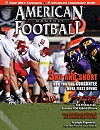Article CategoriesAFM Magazine
|
Moving the Chains – 3 Top College Coaches Show You How To Convert More Third Downs.by: David Purdum© More from this issue Every coach faces critical situations during a game where calling the right play can mean the difference between winning and losing. Often, those situations occur on third and short. What’s your strategy for picking up the critical yards that will keep a drive alive? The top three FBS offenses in terms of third down conversion percentage – Stanford, Nevada and Auburn – share a fundamental philosophy. They run their best plays on the most important down in football. “Third down is one of the two most critical things that happens in football, red-zone football and third-down football,” emphasized Stanford first-year head coach David Shaw, who, as offensive coordinator last season, helped the Cardinal lead the nation in third-down conversion percentage. “It’s very cri....The full article can only be seen by subscribers.
|
|
|||||||
| HOME |
MAGAZINE |
SUBSCRIBE | ONLINE COLUMNISTS | COACHING VIDEOS |
Copyright 2026, AmericanFootballMonthly.com
All Rights Reserved





